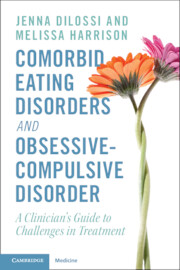 Comorbid Eating Disorders and Obsessive-Compulsive Disorder
Comorbid Eating Disorders and Obsessive-Compulsive Disorder from Part II - Clinical Pitfalls and Treatment Failures
Published online by Cambridge University Press: 14 December 2023
Due to the rates of comorbidity between OCD and EDs, it is common for clinicians to encounter patients with subclinical features of each disorder. This can present in various ways, such as patients having a primary diagnosis of one disorder but with subclinical features of the other, or patients having a subclinical secondary feature of the other disorder. One of the most common co-occurring traits in EDs and OCD is perfectionism, which may present as high achievement, rigidity, overpreparedness, thoroughness, extreme promptness, and checking behaviors related to many domains, but it can also present as avoidant and somewhat scattered. Perfectionism in EDs would typically include content related to diet, eating behaviors, and exercise, whereas in OCD it may be related to morality-based obsessions. Impression management is another trait that is often seen in both disorders, which can cause anxiety and self-doubt. This can make it difficult for patients to be honest with their provider, thus hindering the treatment process. Orthorexia is a subclinical disorder that has traits of both EDs and OCD, highlighting the complication of subclinical features presenting at the same time.
To save this book to your Kindle, first ensure [email protected] is added to your Approved Personal Document E-mail List under your Personal Document Settings on the Manage Your Content and Devices page of your Amazon account. Then enter the ‘name’ part of your Kindle email address below. Find out more about saving to your Kindle.
Note you can select to save to either the @free.kindle.com or @kindle.com variations. ‘@free.kindle.com’ emails are free but can only be saved to your device when it is connected to wi-fi. ‘@kindle.com’ emails can be delivered even when you are not connected to wi-fi, but note that service fees apply.
Find out more about the Kindle Personal Document Service.
To save content items to your account, please confirm that you agree to abide by our usage policies. If this is the first time you use this feature, you will be asked to authorise Cambridge Core to connect with your account. Find out more about saving content to Dropbox.
To save content items to your account, please confirm that you agree to abide by our usage policies. If this is the first time you use this feature, you will be asked to authorise Cambridge Core to connect with your account. Find out more about saving content to Google Drive.